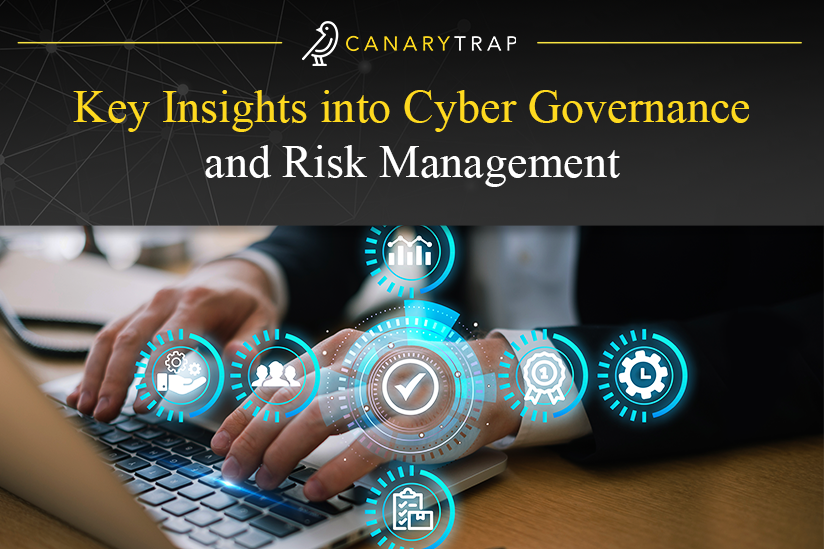Key Insights into Cyber Governance and Risk Management
- October 20, 2023
- Canary Trap
We are living in a hyper-connected world, where businesses rely heavily on digital infrastructure. Unfortunately, with new technology advancements, cyber threats also become more sophisticated and today they are more prevalent than ever before. As a result, effective cyber security governance and risk management have become crucial for organizations of all sizes. In this comprehensive blog post, not only will we delve deeper into what exactly is cyber security governance, how it can benefit organizations, best practices for establishing a robust cyber security governance framework, and effective risk management strategies.
What is Cyber Security Governance?
Cybersecurity governance refers to the framework, policies, processes, and procedures that an organization establishes to manage and oversee its cybersecurity efforts effectively. It involves setting the strategic direction for cybersecurity, defining responsibilities, and ensuring that cybersecurity is integrated into all aspects of the organization’s operations.
The International Standards Organization and International Electrotechnical Commission (ISO/IEC) 27001 standard defines cybersecurity governance as “the system by which an organization directs and controls security governance, specifies the accountability framework and provides oversight to ensure that risks are adequately mitigated, while management ensures that controls are implemented to mitigate risks.”
Why Is It Important?
Cyber governance is essential for protecting an organization’s digital assets because it allows complying with laws and regulations, helps ensure business continuity, and maintain a strong reputation. It’s not just a matter of IT; it’s a strategic imperative for modern businesses in a digitally connected world.
As pointed out in an article by TechTarget, “Historically, cybersecurity was managed by implementing a solution to solve a problem or mitigate a risk. Many cybersecurity departments have technical security safeguards, such as firewalls or intrusion detection, but often lack basic cybersecurity governance policies, best practices and processes. Where they do exist, policies or processes are often outdated or ignored.”
That makes cyber governance fundamentally crucial in today’s digital landscape, because it serves as the bulwark against a relentless wave of evolving cyber threats, providing structured methodologies for threat identification, assessment, and mitigation. Additionally, cyber governance is pivotal for ensuring compliance with ever-evolving legal and regulatory requirements, guarding organizations against potential legal consequences and financial penalties.
Key Components of a Cyber Risk Governance Program
Effective governance begins with leadership from the top, often led by a Chief Information Security Officer (CISO) or equivalent. That’s why there should be clear accountability for cybersecurity responsibilities throughout the organization.
In an article published by Hyperproof it is explained that “Cybersecurity risk management isn’t simply the job of the security team; everyone in the organization has a role to play. […] Effectively managing cybersecurity risk requires all functions to operate with clearly defined roles and tasked with specific responsibilities. The days of siloed departments stumbling along in disconnected confusion are over. Today’s risk landscape requires a unified, coordinated, disciplined, and consistent management solution.”
Now, let’s dig deeper onto the key steps organizations should take in order to build an effective cyber risk governance program:
- Establish a Clear Governance Structure.
A well-defined cybersecurity governance structure is the foundation of a strong defense against cyber threats. This structure should clearly define roles, responsibilities, and reporting lines for cyber security within the organization. Key members include:
Cybersecurity Committee. Formed with representatives from various departments, such as: IT, HR, legal, finance, and senior management. It should oversee cybersecurity efforts.
Chief Information Security Officer (CISO). This position should be appointed to a dedicated person who will be responsible for the overall cybersecurity strategy and implementation.
Risk Owners. These are the people within the organization that are responsible for assessing and mitigating specific risks associated with each area.
- Develop a Comprehensive Cybersecurity Policy
A robust policy framework serves as a guiding document for employees and stakeholders. Ensure that your policy includes:
Acceptable Use Policies. Clearly define how employees should use company resources, systems, and data.
Data Classification. Categorize data based on sensitivity and establish appropriate security controls for each category.
Incident Response Plan. Outline the steps to be taken in the event of a security incident, including reporting procedures and communication protocols.
Third-Party Risk Management. Define how third-party vendors and partners should adhere to your security standards.
- Risk Assessment and Management
Risk assessment is at the core of cyber security governance. Since it involves identifying and assessing cybersecurity risks, organizations need to make informed decisions about how to manage and mitigate those risks, including setting risk tolerance levels and prioritizing security investments. The benefits of conducting regular risk assessments includes:
Identifying vulnerabilities to discover potential weaknesses in your systems, processes, and third-party relationships.
Quantifying risks to assess the impact and likelihood of different cyber threats.
Prioritizing mitigation, focusing on the most critical risks, and implementing controls to reduce exposure.
- Implement Strong Access Controls
Unauthorized access is a common entry point for cyber attacks. Therefore, organizations need to Implement stringent access controls, including:
Role-Based Access Control (RBAC). Grant access privileges based on job roles, ensuring employees only have access to the resources necessary for their responsibilities.
Multi-Factor Authentication (MFA). Require multiple authentication factors for accessing sensitive systems and data.
Regular Access Reviews. Conduct periodic reviews of user access to ensure it remains appropriate.
- Employee Training and Awareness
Employees are often the weakest link in cyber security. Regular training and awareness programs can significantly reduce the risk of insider threats and phishing attacks.
Cybersecurity experts at Security Boulevard add that “GRC (Governance, Risk Management, and Compliance) best practices emphasize the importance of continuous improvement to adapt to changing risks, regulations, and business environments.” That’s why providing ongoing training and developing awareness programs to educate employees is so important to foster this culture of continuous improvement.
With phishing simulations, employees can be trained to recognize and report phishing attempts, but there must be a focus on providing ongoing education on cybersecurity best practices.
- Continuous Monitoring and Threat Detection
Implement continuous monitoring tools and practices to detect and respond to cyber threats in real-time. For example:
Intrusion Detection Systems (IDS). Deploying IDS helps identify suspicious network activity.
Security Information and Event Management (SIEM) Tools. SIEM solutions help centralize log data and detect anomalies.
Shannon Flynn at Business.com points out that “Most organizations don’t have the staff to monitor their networks manually, but software solutions can automate the process. Some programs search for breaches, some for unusual user activity and others for dormant malware. No matter what your situation entails, you can likely find monitoring software that fits your needs.”
- Incident Response and Recovery Plan
Even with robust prevention measures, incidents can still occur. An effective incident response plan should include:
Clearly Defined Roles. Designate who is responsible for each aspect of incident response.
Communication Plan. Establish a clear communication plan for notifying stakeholders and authorities.
Backup and Recovery. Make regular backups of critical data and test recovery procedures.
- Regular Security Audits and Compliance Checks
Conduct regular security audits and compliance checks to ensure your cyber security measures align with industry standards and regulatory requirements, including: data protection laws, industry-specific regulations, and international standards like ISO 27001. This helps in identifying gaps and areas that need improvement.
- Cyber Insurance
Cyber insurance is crucial in modern risk management because it shields businesses from the financial fallout of cyber threats, helps maintain reputation and customer trust, ensures legal and regulatory compliance, and covers third-party liabilities.
In this day and age, cyber insurance has become a vital tool in modern risk management. Therefore, organizations should consider investing in cyber insurance as a proactive measure to mitigate financial losses in case of a cyber attack.
Cyber insurance is not a substitute for robust cybersecurity practices but rather a complementary tool that can significantly reduce the financial and operational impact of cyber threats, because it helps support business continuity, can be customized, and provides peace of mind. It’s a safety net against the rising tide of cyber risks.
- Stay Informed and Adapt
A critical aspect of cybersecurity governance is the commitment to ongoing improvement. This includes assessing and managing the risks associated with third-party vendors and partners, learning from previous security incidents and adapting strategies to respond accordingly. By focusing on training and security awareness of all employees, organizations can ensure cybersecurity is not just an IT issue, but a business-wide concern.
The cyber threat landscape is constantly evolving. That’s why it’s so important to stay informed about emerging threats and adapt your cyber security governance and risk management strategies accordingly. Join industry forums, participate in information sharing, and collaborate with peers to bolster your defenses.
Experts at UpGuard highlight that “one of the key parts of cyber risk governance is its accountability framework. Somebody needs to ensure that people follow the cyber risk governance guidelines. The cyber risk program must measure performance across departments and systems and ensure that those identified as responsible for meeting objectives are aware of the results and work with the cyber risk governance leaders to achieve and enhance them.”
In Conclusion
In a digital world where cyber threats are ever-present, cyber security governance and risk management are not optional but essential for any organization. By establishing a clear governance structure, developing comprehensive policies, and continuously monitoring and adapting to evolving threats, businesses can build resilient defenses against cyber attacks and safeguard their sensitive data and operations.
Effective governance involves measuring and reporting on the organization’s cybersecurity posture. Key performance indicators (KPIs) and metrics are used to track progress and identify areas for improvement. Governance should also include plans for educating employees and stakeholders about cybersecurity best practices and policies, since regular training and awareness programs are essential for risk management.
Remember, cyber security is an ongoing journey, and staying proactive is the key to success in this ever-changing landscape. Implementing these best practices will not only protect your organization but also enhance its overall cyber resilience and reputation in an increasingly interconnected world.
SOURCES:
- https://www.techtarget.com/searchsecurity/post/Cybersecurity-governance-A-path-to-cyber-maturity
- https://hyperproof.io/resource/cybersecurity-risk-management-process/
- https://securityboulevard.com/2023/07/implementing-grc-best-practices-for-enhanced-governance-and-risk-management/
- https://www.business.com/insurance/cybersecurity-risk-management/
- https://www.upguard.com/blog/cyber-risk-governance#toc-0

